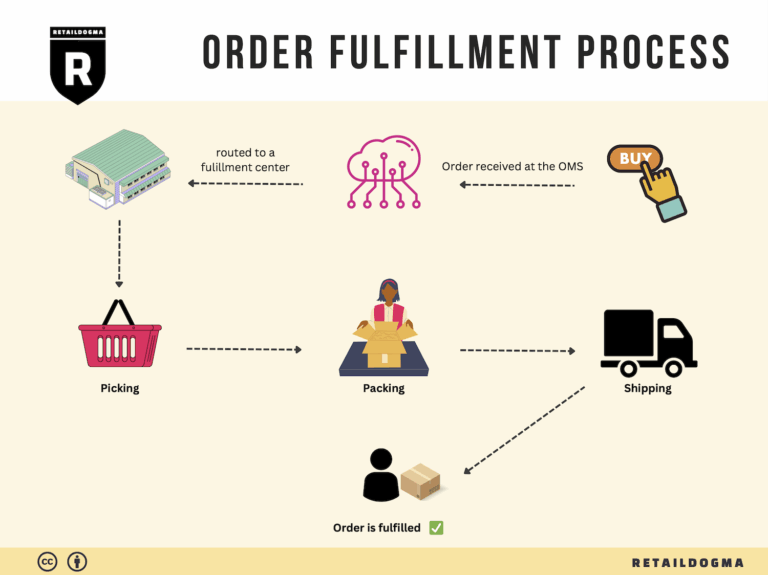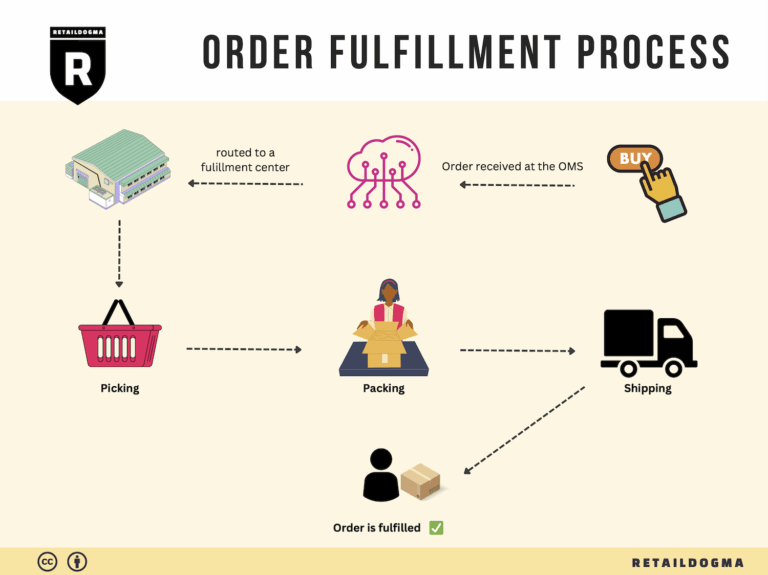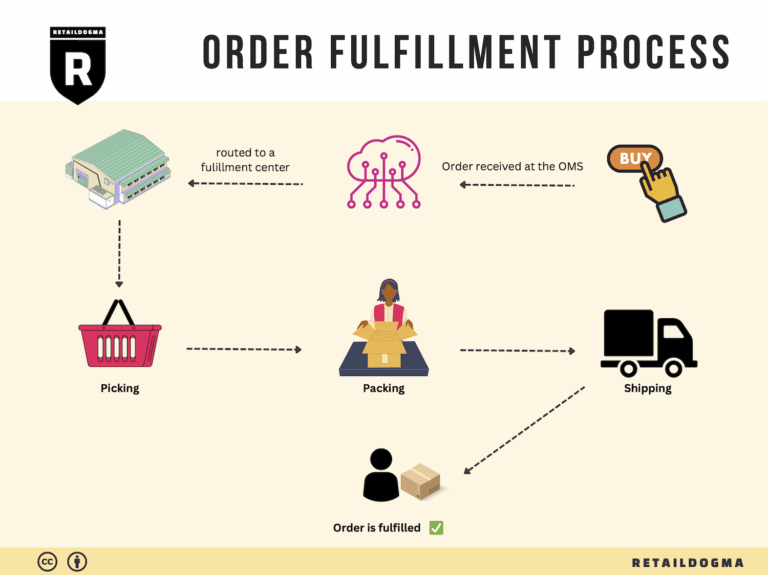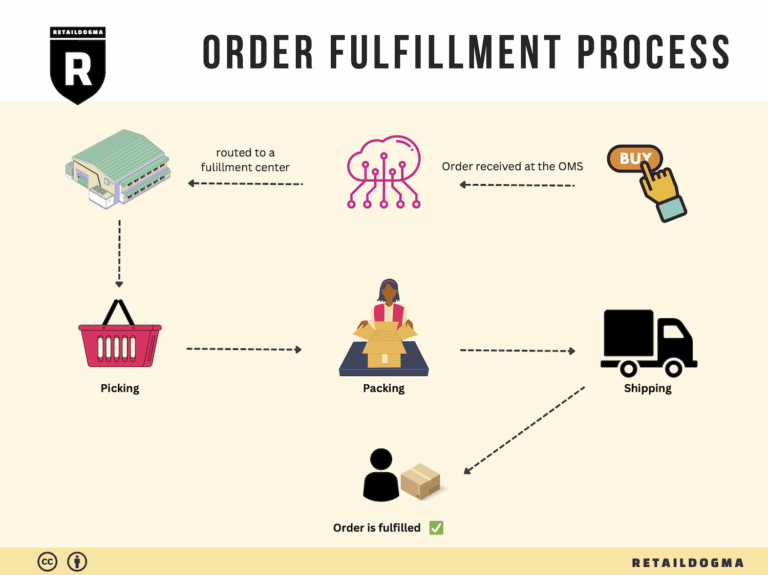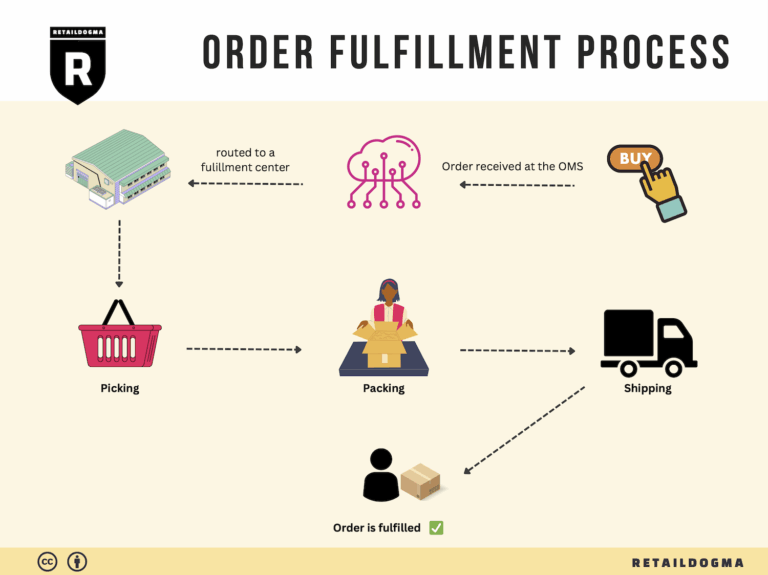How Order Fulfillment Works: A Step-by-Step Guide for Businesses
What is E-commerce Fulfillment? An Introduction for Growing Businesses
Understanding E-commerce Fulfillment
For many growing online businesses, the excitement of increasing sales can quickly turn into a daunting challenge when it comes to packing and shipping orders. As sales volumes rise, the logistical complexities of fulfilling orders can overwhelm even the most dedicated entrepreneurs. From managing inventory and packing products to ensuring timely delivery and handling returns, the fulfillment process can become a significant drain on resources and energy. This is where a well-structured fulfillment strategy becomes essential.
At its core, e-commerce fulfillment refers to the process of getting a product from your inventory to the customer’s doorstep. It encompasses everything from order processing and inventory management to packing, shipping, and returns. A streamlined fulfillment operation is crucial not only for customer satisfaction but also for maintaining a competitive edge in the fast-paced e-commerce landscape.
This guide aims to demystify e-commerce fulfillment for growing businesses by covering several key areas:
-
Fulfillment Models: We will explore various fulfillment models, including Third-Party Logistics (3PL) and Fulfilled by Amazon (FBA), highlighting the advantages and disadvantages of each. Understanding these options will help you determine which model aligns best with your business needs.
-
Core Services: We will break down the core services typically offered by fulfillment partners, including storage, order processing, shipping, and returns management. Knowing what services to expect can help you make informed decisions when selecting a fulfillment partner.
-
Choosing a Partner: Selecting the right fulfillment partner is critical to your success. We will provide practical tips on what to look for in a partner, including scalability, technology integration, and customer service capabilities.
-
Pricing: Finally, we will discuss pricing structures commonly associated with fulfillment services. Understanding the cost implications of different fulfillment options will enable you to budget effectively and avoid unexpected expenses.
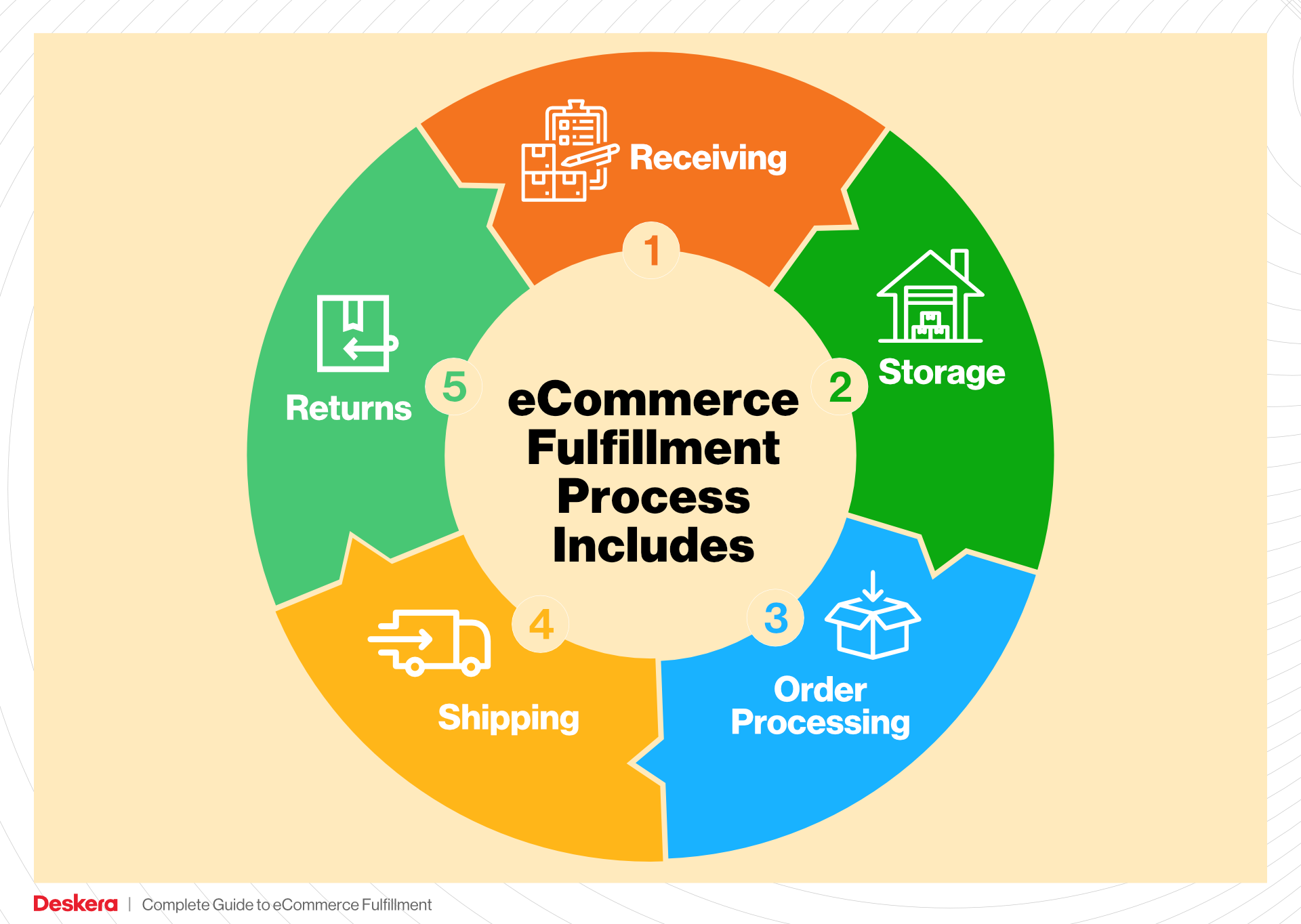
The ultimate goal of this guide is to empower you, the business owner, to make informed and strategic decisions about your logistics operations. By understanding the ins and outs of e-commerce fulfillment, you can streamline your processes, enhance customer satisfaction, and focus on what you do best: growing your business. Let’s dive in and explore how effective fulfillment can transform your e-commerce operations.
What You’ll Learn In This Guide
- What is E-commerce Fulfillment? An Introduction for Growing Businesses
- The Order Fulfillment Process: From ‘Buy’ Button to Customer’s Door
- Comparing Fulfillment Models: In-House vs. 3PL vs. Dropshipping
- A Deep Dive into Amazon FBA: Pros, Cons, and Who It’s For
- Core Services Offered by Fulfillment Centers
- How to Choose a Fulfillment Partner: A 6-Point Checklist
- Understanding Fulfillment Pricing: A Breakdown of Common Fees
- Frequently Asked Questions (FAQs) about Fulfillment
- Conclusion: Is Outsourcing Fulfillment the Right Move for Your Business?
- Important Disclaimer
The Order Fulfillment Process: From ‘Buy’ Button to Customer’s Door
1. Receiving Inventory
The order fulfillment process begins with receiving inventory at the fulfillment center. When a seller partners with Walmart Fulfillment Services (WFS), they send their products to Walmart’s designated fulfillment centers. Upon arrival, the inventory is inspected for quality and accuracy against the shipment manifest. This step is crucial as it ensures that the items are in good condition and that the correct quantities have been received.
Key Term: SKU
A Stock Keeping Unit (SKU) is a unique identifier for each product. Proper management of SKUs during the receiving phase helps in tracking inventory accurately and facilitates smooth operations in subsequent steps of the fulfillment process.
2. Warehouse Storage
Once the inventory is received and verified, the next step is warehouse storage. Products are systematically organized in the fulfillment center, often categorized by type or demand frequency. This strategic placement is essential for optimizing space and ensuring that items can be easily located when orders come in.
Effective warehouse storage minimizes the time spent searching for items and reduces the chances of errors during order processing. Additionally, a well-organized storage system aids in inventory management, helping sellers keep track of stock levels and plan for restocking.
Key Term: FIFO (First In, First Out)
FIFO is a method of inventory management where the oldest stock is sold first. This practice is particularly important for perishable goods but is also beneficial for maintaining overall inventory freshness and reducing excess stock.
3. Order Picking
When a customer places an order on Walmart.com, the fulfillment process moves into the order picking phase. This involves retrieving the purchased items from storage based on a “pick list,” which details the items and their respective locations within the warehouse.
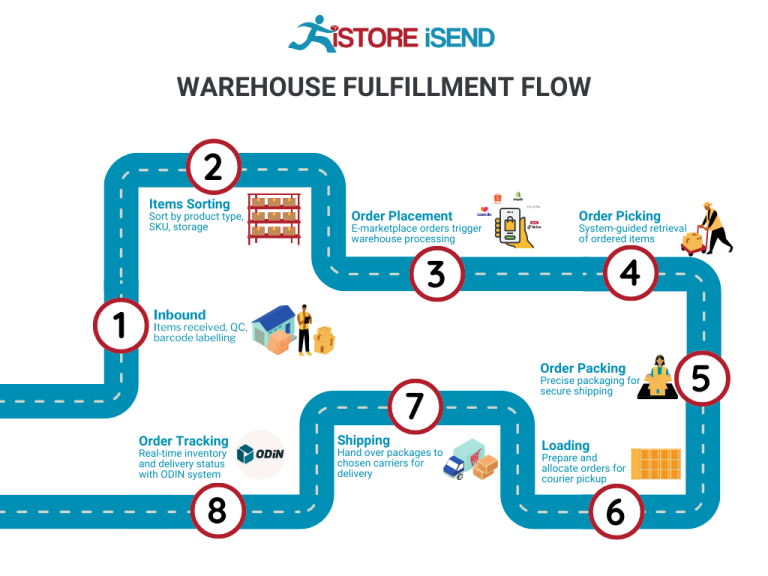
Efficient order picking is vital as it directly impacts order accuracy and fulfillment speed. The faster and more accurate the picking process, the quicker the order can be packed and shipped, enhancing the overall customer experience.
Key Term: Pick List
A pick list is a document or digital tool that guides warehouse staff in locating items to fulfill a customer order. It streamlines the picking process and ensures that the correct products are selected.
4. Order Packing
After items have been picked, they move to the packing stage. Here, products are carefully packaged to ensure they arrive at the customer’s doorstep in perfect condition. Proper packing involves selecting the right materials and methods to protect the products during transit while also considering cost-effectiveness.
This step is crucial not only for maintaining product integrity but also for branding. Thoughtful packaging can enhance the customer experience and encourage repeat business. Additionally, packing efficiency can influence shipping costs, as the size and weight of packages directly affect shipping fees.
Key Term: Packaging Optimization
Packaging optimization refers to the process of designing packaging that is both protective and cost-effective. This can include using the right box sizes and materials to minimize waste and reduce shipping costs.
5. Shipping & Delivery
The final step in the order fulfillment process is shipping and delivery. Once packed, orders are handed off to shipping carriers, who transport the packages to the customer’s address. WFS offers various shipping options, including 2-day delivery for eligible items, which enhances customer satisfaction and encourages more purchases.
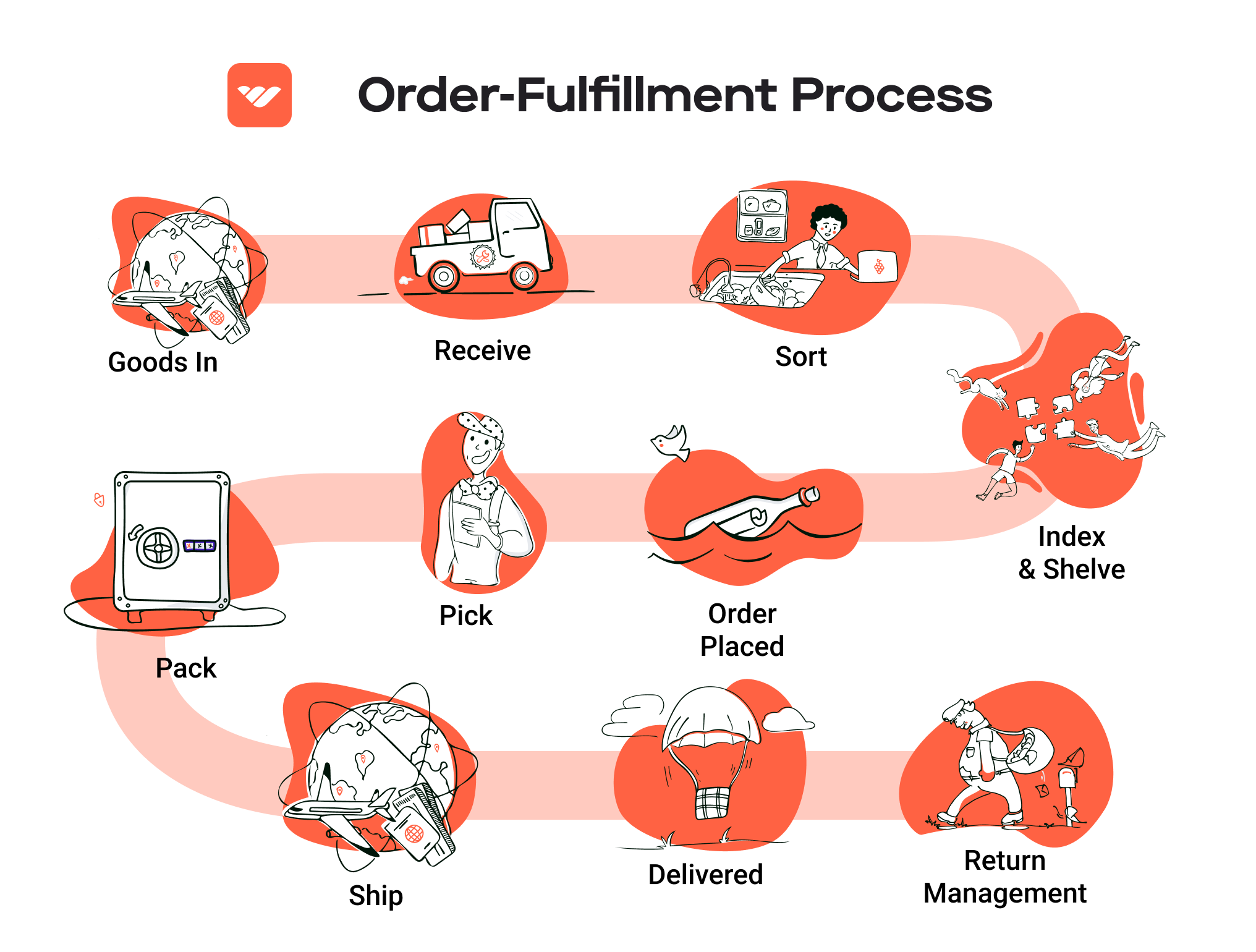
Timely and reliable shipping is critical for e-commerce success. It not only affects customer satisfaction but also influences the seller’s reputation on platforms like Walmart. Customers expect their orders to arrive quickly and in good condition, so efficient shipping processes are essential.
Key Term: Last-Mile Delivery
Last-mile delivery refers to the final step of the delivery process, where the package is transported from a distribution center to the customer’s doorstep. This is often the most challenging and costly part of the shipping process, making it vital for businesses to optimize their logistics to ensure timely deliveries.
In summary, understanding and effectively managing each step of the order fulfillment process—from receiving inventory to shipping and delivery—is crucial for e-commerce business owners and operations managers looking to scale their logistics efficiently. By leveraging services like Walmart Fulfillment Services, sellers can streamline these processes, enhance customer satisfaction, and ultimately drive growth.
Comparing Fulfillment Models: In-House vs. 3PL vs. Dropshipping
Fulfillment Model Comparison
| Model | Who Handles Inventory | Best For (Business Stage) | Key Advantage | Key Disadvantage |
|---|---|---|---|---|
| In-House Fulfillment | The business itself | Startups to established businesses | Complete control over inventory and processes | High overhead costs and resource allocation |
| Third-Party Logistics (3PL) | An external logistics provider | Growing businesses and scale-ups | Cost-effective and scalable logistics solutions | Less control over fulfillment process and quality |
| Dropshipping | Suppliers or manufacturers | New entrepreneurs and niche sellers | Low upfront investment and no inventory management | Lower profit margins and reliance on suppliers’ stock |
In-House Fulfillment
In-house fulfillment involves managing your own inventory and handling all aspects of order processing, from storage to packing and shipping. This model allows businesses to maintain full control over their products and fulfillment processes, which can enhance quality assurance and customer satisfaction. For startups or established businesses with sufficient resources, in-house fulfillment can be advantageous as it allows for personalized service and direct oversight of logistics. However, this model can also be burdensome, as it demands significant investment in warehousing, labor, and technology. Over time, operational costs may escalate, particularly as order volumes increase or during peak seasons, where the need for additional labor and storage space can strain resources. Additionally, managing returns, inventory levels, and shipping logistics can divert attention from core business activities, limiting growth potential.
Third-Party Logistics (3PL)
Third-party logistics (3PL) providers offer businesses a way to outsource their fulfillment processes. By partnering with a 3PL, businesses can leverage the provider’s established infrastructure, which includes warehousing, inventory management, and shipping capabilities. This model is particularly beneficial for growing businesses that need to scale quickly without incurring the high costs associated with in-house logistics. A significant advantage of using a 3PL is that it allows businesses to focus on their core competencies, such as product development and marketing, while leaving the complexities of logistics to specialists. Furthermore, 3PLs often have access to better shipping rates and can offer faster delivery times, which can improve customer satisfaction. However, businesses may face challenges related to reduced control over inventory management and fulfillment processes, which can impact service levels if the 3PL does not meet expectations. Transparency in operations and communication with the provider is crucial to mitigate these risks.
Dropshipping
Dropshipping is a fulfillment model where the retailer does not keep products in stock but instead transfers customer orders and shipment details to a manufacturer or wholesaler, who then ships the products directly to the customer. This model is particularly appealing for new entrepreneurs and niche sellers, as it requires minimal upfront investment in inventory and eliminates the need for warehousing. As a result, dropshipping allows for a wide product selection without the associated risks of unsold stock. However, the dropshipping model comes with its own set of challenges. The most significant drawback is the typically lower profit margins, as suppliers often set retail prices and control stock availability. Additionally, businesses relying on dropshipping are at the mercy of their suppliers regarding inventory management, shipping times, and product quality. Any delays or issues on the supplier’s end can lead to customer dissatisfaction and harm the retailer’s reputation. Thus, while dropshipping can be an accessible entry point into e-commerce, it requires careful selection of reliable suppliers and effective management of customer expectations.
In conclusion, each fulfillment model presents unique advantages and disadvantages, and the best choice will depend on the specific needs, resources, and growth stage of the business. Understanding these models in depth enables e-commerce business owners to make informed decisions that align with their operational strategies and growth objectives.
A Deep Dive into Amazon FBA: Pros, Cons, and Who It’s For
Understanding Fulfillment by Amazon (FBA)
Fulfillment by Amazon (FBA) is a service provided by Amazon that allows sellers to store their products in Amazon’s fulfillment centers. Amazon takes care of storage, packaging, and shipping, as well as customer service and returns. This enables sellers to leverage Amazon’s vast logistics network, which can significantly enhance their ability to reach a wider audience and improve customer satisfaction.
How FBA Works
-
Setting Up an Account: To start using FBA, sellers need to create an Amazon seller account and register for the FBA service.
-
Product Preparation: Sellers prepare their products according to Amazon’s guidelines, which include labeling and packaging requirements.
-
Shipping to Amazon: Once products are ready, sellers ship their inventory to Amazon’s fulfillment centers. Amazon provides shipping guidelines and can even arrange for discounted shipping through their partnered carriers.
-
Storage and Management: Products are stored in Amazon’s warehouses, where they are available for customers to purchase. Sellers can manage their inventory through the Amazon Seller Central dashboard.
-
Order Fulfillment: When a customer orders a product, Amazon picks, packs, and ships the item on behalf of the seller. Customers benefit from fast shipping options, including Amazon Prime.
-
Customer Service and Returns: Amazon handles all customer service inquiries and returns, ensuring a seamless experience for buyers.
Pros of Using FBA
Prime Eligibility
One of the most significant advantages of FBA is the eligibility for Amazon Prime. Products fulfilled by Amazon are eligible for Prime, which offers customers free two-day shipping. This can lead to increased sales, as Prime members are more likely to purchase items that come with this shipping benefit.
Customer Trust
When customers see the “Fulfilled by Amazon” label, it instills a sense of trust. Amazon is known for its reliable shipping and customer service, which can lead to higher conversion rates for sellers. Buyers are often more willing to purchase from sellers who utilize FBA due to the assurance of a positive buying experience.
Multi-Channel Fulfillment
FBA is not limited to Amazon alone. Sellers can utilize Amazon’s fulfillment services to ship products sold on other platforms, such as eBay or their own e-commerce websites. This multi-channel fulfillment capability allows sellers to centralize their inventory and streamline their shipping processes, ultimately saving time and resources.
Scalability
FBA allows businesses to scale quickly without the burden of managing logistics. As demand for products increases, sellers can send more inventory to Amazon’s fulfillment centers, enabling them to meet customer expectations without having to invest in their own warehousing and shipping infrastructure.
Comprehensive Reporting
Sellers using FBA gain access to detailed analytics and reporting tools within Amazon Seller Central. These tools help sellers track inventory levels, sales performance, and shipping metrics, enabling them to make informed decisions about their business.
Cons of Using FBA
High Fees
While FBA offers numerous benefits, it comes at a cost. Amazon charges various fees, including storage fees for holding inventory and fulfillment fees for picking, packing, and shipping orders. These costs can add up, particularly for sellers with low margins or those selling slower-moving products.
Strict Inventory Rules
FBA has stringent inventory management policies. Sellers must adhere to specific guidelines regarding packaging, labeling, and storage. Failure to comply with these rules can result in additional fees or even the removal of inventory from Amazon’s warehouses. This can be particularly burdensome for new sellers who may not be familiar with the requirements.
Commingling Risks
FBA utilizes a commingling process, where products from different sellers may be stored together in the same inventory. This can pose a risk for sellers, as it may lead to issues with product quality and accountability. If a customer receives a defective or damaged item, it can be difficult to trace the source, potentially harming the seller’s reputation.
Limited Control Over Fulfillment
By outsourcing fulfillment to Amazon, sellers relinquish some control over the shipping process. This includes the ability to customize packaging or offer unique unboxing experiences. For brands that prioritize customer experience, this can be a significant drawback.
Inventory Limitations
Amazon may impose inventory limits based on a seller’s sales history and performance metrics. This can restrict a seller’s ability to stock up on inventory during peak sales seasons, potentially leading to lost sales opportunities.
Who is FBA Best For?
Fulfillment by Amazon is best suited for sellers who:
-
Have a High Sales Volume: Sellers with a consistent sales history can benefit from the economies of scale offered by FBA, as the cost per unit decreases with higher volume.
-
Sell Products with Fast Turnover: FBA is ideal for sellers of products that sell quickly, as the storage fees can be offset by the volume of sales.
-
Focus on Brand Trust: Businesses looking to enhance their brand’s credibility can leverage Amazon’s reputation to gain customer trust.
-
Want to Save Time on Logistics: Entrepreneurs who prefer to focus on product development, marketing, and customer engagement rather than managing logistics will find FBA to be a valuable solution.
-
Are Expanding into New Markets: Sellers looking to enter new geographic markets can benefit from Amazon’s established logistics network without needing to set up their own operations.
In conclusion, while Fulfillment by Amazon offers a robust solution for many e-commerce businesses, it is essential for sellers to weigh the pros and cons carefully. Understanding the fee structure, compliance requirements, and the impact on brand identity will help businesses determine if FBA aligns with their growth strategy.
Core Services Offered by Fulfillment Centers
Inventory Management & Warehousing
Inventory management and warehousing are critical components of fulfillment services, providing businesses with the ability to store, track, and manage their stock efficiently. Fulfillment centers, like Walmart Fulfillment Services (WFS), utilize advanced inventory management systems to offer real-time visibility into stock levels, ensuring that businesses can maintain optimal inventory without overstocking or understocking.
Benefits:
-
Streamlined Operations: By outsourcing warehousing to a fulfillment center, e-commerce businesses can focus on core activities such as product development and marketing, rather than managing physical inventory.
-
Scalability: Fulfillment centers offer flexible storage solutions that can adapt to seasonal fluctuations in demand. Businesses can easily scale their inventory up or down without the constraints of a fixed warehouse space.
-
Cost Efficiency: Many fulfillment centers provide cost-effective storage rates, allowing businesses to save on overhead costs associated with leasing or maintaining their own warehouses.
-
Accurate Stock Tracking: With sophisticated tracking systems, businesses can monitor their inventory levels and receive alerts for low stock, reducing the risk of lost sales due to stockouts.
Pick and Pack Services
Pick and pack services are fundamental to the order fulfillment process, involving the selection of items from inventory and packing them for shipment. Fulfillment centers handle this process efficiently, ensuring that orders are processed quickly and accurately.
Benefits:
-
Faster Order Processing: Fulfillment centers are equipped with optimized picking routes and efficient packing processes, which significantly reduce the time taken to fulfill orders. This is especially important for e-commerce businesses that promise quick delivery times.
-
Accuracy in Fulfillment: Professional pick and pack services minimize errors in order fulfillment, ensuring that customers receive the correct items. This accuracy helps maintain customer satisfaction and reduces the costs associated with returns and exchanges.
-
Customized Packaging: Many fulfillment centers offer tailored packaging options that enhance the unboxing experience for customers. This can include branded packaging or eco-friendly materials, which can improve brand perception and customer loyalty.
-
Integration with Technology: Fulfillment centers often use technology to automate the picking and packing process. This integration leads to increased efficiency and reduces the likelihood of human error.
Kitting and Assembly
Kitting and assembly services involve combining multiple products into a single package or preparing products for sale. This service is particularly beneficial for businesses that sell bundled products or require assembly before shipping.
Benefits:
-
Enhanced Product Offerings: By utilizing kitting services, e-commerce businesses can create unique product bundles or kits that appeal to customers. This can lead to increased sales and average order values.
-
Time Savings: Outsourcing kitting and assembly to fulfillment centers frees up internal resources, allowing businesses to focus on other important aspects of their operations.
-
Quality Control: Fulfillment centers typically have quality control measures in place to ensure that assembled products meet specific standards before they are shipped. This helps maintain product quality and customer satisfaction.
-
Simplified Supply Chain: Kitting services streamline the supply chain by consolidating multiple SKUs into a single item. This simplification can reduce complexity in inventory management and logistics.
Returns Management (Reverse Logistics)
Returns management, often referred to as reverse logistics, is a crucial service provided by fulfillment centers. This process involves handling customer returns efficiently, including the processing, restocking, and managing of returned items.
Benefits:
-
Improved Customer Experience: A seamless returns process can significantly enhance the customer experience. Fulfillment centers often provide easy-to-follow return instructions and handle customer inquiries, leading to higher satisfaction rates.
-
Cost Control: Effective returns management helps businesses minimize costs associated with returns. Fulfillment centers can quickly process returns and determine whether items can be restocked, repaired, or discarded.
-
Data Insights: Fulfillment centers can provide valuable insights into return trends and reasons for returns. This data can help e-commerce businesses identify product issues, improve quality, and refine their offerings.
-
Omnichannel Returns: Many fulfillment centers offer omnichannel return solutions, allowing customers to return items through various channels, including in-store or by mail. This flexibility can enhance customer loyalty and retention.
In conclusion, leveraging the core services offered by fulfillment centers can greatly benefit e-commerce businesses looking to scale their operations. By outsourcing inventory management, pick and pack services, kitting and assembly, and returns management, businesses can enhance efficiency, improve customer satisfaction, and ultimately drive growth in a competitive marketplace.
How to Choose a Fulfillment Partner: A 6-Point Checklist
Location & Warehouse Network
Importance: The geographical location of your fulfillment partner’s warehouses significantly impacts shipping times and costs. A partner with a strategically placed network of warehouses can provide faster delivery, reduce shipping costs, and enhance customer satisfaction.
Questions to Ask:
– Where are your warehouses located, and how do they align with my target customer demographics?
– What is your average shipping time to key regions, and do you offer expedited shipping options?
– How many fulfillment centers do you operate, and how do you manage inventory across them?
Technology & Integrations
Importance: In today’s digital landscape, technology plays a crucial role in managing logistics efficiently. A fulfillment partner should offer robust technology solutions that integrate seamlessly with your existing e-commerce platforms.
Questions to Ask:
– What technology do you use for inventory management, order processing, and tracking shipments?
– Do you have integrations with popular e-commerce platforms (e.g., Shopify, WooCommerce, Amazon) and ERP systems?
– How do you ensure real-time visibility of inventory levels and order status?
Specializations (e.g., Cold Storage, Oversized Items)
Importance: Depending on the nature of your products, you may require specialized fulfillment capabilities. For instance, if you sell perishable goods, a partner with cold storage facilities is essential. Similarly, oversized items may require unique handling and shipping processes.
Questions to Ask:
– Do you have specialized facilities for handling specific product types, such as perishable goods or oversized items?
– What protocols do you have in place for managing temperature-sensitive inventory?
– Can you accommodate unique packaging requirements for my products?
Scalability & Capacity
Importance: As your business grows, your fulfillment partner must be able to scale operations accordingly. A partner that cannot accommodate increased demand may hinder your growth potential and lead to fulfillment delays.
Questions to Ask:
– What is your current capacity, and how do you handle peak seasons or unexpected surges in demand?
– Can you provide case studies or examples of how you have scaled operations for other clients?
– What is your process for managing seasonal fluctuations in inventory and order volume?
Pricing and Contracts
Importance: Understanding the pricing structure and contract terms is vital for maintaining profitability and avoiding unexpected costs. Look for transparency in pricing and flexibility in contract terms that accommodate your business needs.
Questions to Ask:
– What is your pricing model (e.g., per order, per item, monthly fees) and are there any additional costs I should be aware of?
– Can you provide a breakdown of all fees, including storage, picking, packing, and shipping?
– Are there any long-term contracts, and what are the terms for cancellation or adjustments?
Customer Support & Reviews
Importance: Reliable customer support is crucial for resolving issues quickly and efficiently. Additionally, positive reviews from other businesses can provide insights into the partner’s reliability and performance.
Questions to Ask:
– What customer support options do you provide (e.g., phone, email, chat), and what are your support hours?
– Can you share references or case studies from current or past clients?
– How do you handle issues such as shipping delays or inventory discrepancies, and what is your protocol for communicating these issues to clients?
Conclusion
Choosing the right fulfillment partner is a critical decision that can significantly impact your e-commerce business’s success. By carefully considering these six key areas and asking the right questions, you can identify a partner that aligns with your operational needs and supports your growth ambitions. Prioritize transparency, scalability, and technological compatibility to ensure a smooth and efficient fulfillment process that enhances customer satisfaction and drives sales.
Understanding Fulfillment Pricing: A Breakdown of Common Fees
Initial Setup Fees
When partnering with a fulfillment service like Walmart Fulfillment Services (WFS), the initial setup fees are generally minimal or non-existent. WFS has a streamlined onboarding process that allows sellers to create a Marketplace seller account without incurring hefty fees. This is advantageous for e-commerce businesses, especially those just starting, as it enables them to allocate more resources towards inventory and marketing rather than upfront costs. Any costs associated with setting up your inventory listings or integrating with WFS are typically absorbed within the service itself, making it easier for sellers to start selling quickly.
Receiving Fees
Receiving fees are charged when your inventory arrives at the fulfillment center. This fee covers the labor and resources needed to unload, inspect, and store your products. For WFS, these fees are typically calculated based on the number of units received and may vary depending on the weight and size of the items. For example, larger or heavier products may incur higher receiving fees due to the additional handling required. It’s crucial for sellers to understand these costs upfront, as they can vary significantly based on the nature of the products being shipped.
Storage Fees (per pallet/bin)
Storage fees are incurred for the space your inventory occupies in the fulfillment center. These fees are usually calculated on a per-pallet or per-bin basis and can vary by season. For example, during peak shopping seasons, such as the holiday period, storage fees may increase due to higher demand for space. WFS generally offers competitive rates that are 15% lower than other marketplace fulfillment providers, making it an attractive option for sellers. To manage these costs effectively, sellers should regularly monitor their inventory turnover rates and adjust their stock levels accordingly, ensuring they aren’t paying for excess storage.
Pick & Pack Fees (per item/order)
Pick and pack fees are charged for the process of selecting items from inventory (picking) and preparing them for shipment (packing). These fees are typically calculated per item or per order, depending on the fulfillment provider’s pricing structure. For instance, WFS utilizes a straightforward model where sellers pay a fixed fee for each item picked and packed. This pricing approach simplifies budgeting for e-commerce businesses and allows for better forecasting of fulfillment costs. It’s essential for sellers to consider the nature of their products when estimating these fees, as orders with multiple items may incur higher cumulative costs.
Shipping Fees
Shipping fees are incurred when orders are dispatched to customers. These fees are calculated based on various factors, including the destination, the weight of the package, and the shipping method chosen. WFS prides itself on offering competitive shipping rates, leveraging Walmart’s extensive logistics network to provide cost-effective solutions for sellers. Importantly, WFS allows for 2-day shipping on eligible items, significantly enhancing customer satisfaction and potentially increasing sales. Businesses should factor in shipping fees when setting product prices to ensure profitability while remaining competitive in the marketplace.
Tips for Getting an Accurate Quote
-
Understand Your Product Dimensions and Weight: Accurate measurements are crucial for calculating receiving, storage, and shipping fees. Be sure to account for packaging as well.
-
Analyze Your Inventory Turnover: Regularly assess how quickly your products sell. High turnover can mitigate storage costs, while slow-moving items may lead to increased fees.
-
Consult with WFS: Utilize the personalized seller support offered by WFS to clarify any uncertainties about fees. They can provide tailored advice based on your unique business needs.
-
Factor in Seasonal Changes: Be aware of peak seasons and how they may affect fulfillment costs. Planning ahead can help mitigate unexpected expenses.
-
Utilize WFS Tools: Leverage tools such as the WFS calculator provided on the Walmart Marketplace to estimate potential fees based on your inventory and sales volume.
By understanding and monitoring these fulfillment pricing models, e-commerce business owners can make informed decisions, optimize their logistics strategies, and ultimately enhance their profitability when selling through Walmart Fulfillment Services.
Frequently Asked Questions (FAQs) about Fulfillment
1. What is Walmart Fulfillment Services (WFS)?
Walmart Fulfillment Services (WFS) is a logistics solution that allows sellers on Walmart Marketplace to leverage Walmart’s extensive supply chain for inventory storage, order processing, and shipping. WFS handles everything from receiving your inventory to delivering orders to customers, including returns and customer service.
2. How does WFS work?
To use WFS, you need to create a seller account on Walmart Marketplace and set up your WFS profile. Once your items are listed, you send your inventory to Walmart fulfillment centers. When a customer places an order, WFS takes care of picking, packing, and shipping the item, usually within two days.
3. What are the costs associated with using WFS?
WFS charges are straightforward and competitive, averaging about 15% less than other marketplace fulfillment providers. You will pay for storage, picking, packing, and shipping based on the items you send. There are no hidden fees, monthly fees, or setup costs.
4. Are there any inventory requirements for using WFS?
There are no minimum or maximum inventory requirements for WFS. However, it is recommended to start with at least 50 items to fully leverage the benefits and growth potential of the service.
5. What types of products can I ship with WFS?
You can ship a wide range of products with WFS, provided they weigh up to 500 lbs and meet the size restrictions of 120” x 105” x 93”. Items must not require temperature control and must comply with Walmart’s prohibited products policy.
6. What is the difference between a warehouse and a fulfillment center?
A warehouse is primarily used for storing goods, while a fulfillment center focuses on processing orders and shipping products to customers. Fulfillment centers are equipped to handle the logistics of order management, including inventory tracking and customer service.
7. Can I fulfill orders from channels other than Walmart.com using WFS?
Yes, WFS offers a Multichannel Solutions program that allows you to fulfill orders from other sales channels while leveraging Walmart’s logistics infrastructure.
8. What is a Third-Party Logistics provider (3PL)?
A Third-Party Logistics provider (3PL) is a company that offers outsourced logistics services, including warehousing, transportation, and order fulfillment. WFS acts as a 3PL specifically for sellers on Walmart Marketplace.
9. How can I improve sales using WFS?
To accelerate revenue growth with WFS, ensure your prices are competitive, provide high-quality product listings, maintain sufficient inventory, and consider joining Walmart Sponsored Search to enhance visibility for your listings.
10. What should I do if I have questions or need support while using WFS?
Walmart provides personalized seller support through dedicated associates available seven days a week. You can also access a wealth of resources and educational materials through the Walmart Marketplace Learn platform to assist you in optimizing your fulfillment processes.
Conclusion: Is Outsourcing Fulfillment the Right Move for Your Business?
Assessing the Benefits of Outsourcing Fulfillment
Outsourcing your fulfillment process can be a transformative move for your business, particularly in today’s competitive e-commerce landscape. By leveraging a fulfillment service, such as Walmart Fulfillment Services (WFS), businesses can significantly save time and resources. This allows you to focus on core activities like product development and marketing while the fulfillment partner handles the logistics of storage, order processing, and shipping.
One of the most compelling benefits is scalability. As your business grows, so does the complexity of managing inventory and order fulfillment. A reliable partner offers the flexibility to adjust your inventory levels in response to fluctuating demand, ensuring that you can meet customer expectations without overextending your resources. Moreover, fulfillment services come equipped with industry expertise and established supply chain networks, which can lead to cost savings and improved delivery times. For instance, businesses utilizing WFS have reported an average GMV growth of 50% for items tagged as “Fulfilled by Walmart.”
However, it’s crucial to choose the right fulfillment partner that aligns with your business goals. Consider factors such as cost, customer service capabilities, and integration with your existing systems. A strategic partnership can be a significant driver for growth, transforming your logistics from a burden into a competitive advantage.
Call to Action
To determine if a fulfillment partner is the right next step for your business, conduct a thorough audit of your current shipping and fulfillment processes. Evaluate your operational costs, delivery times, and customer satisfaction levels. By understanding your current capabilities and limitations, you can make an informed decision on whether to outsource fulfillment and identify the right partner to help you scale effectively.
Important Disclaimer
⚠️ Important Disclaimer
The information in this guide is for educational purposes. Fulfillment services, pricing, and platform features change frequently. Always conduct your own due diligence and consult with providers directly before making business decisions.

